Hernia
| Hernia | |
|---|---|
 | |
| Diagram of anindirect inguinal hernia(view from the side) | |
| Specialty | General surgery |
| Symptoms | Pain especially with coughing, bulging area[1] |
| Complications | Bowel strangulation[1] |
| Usual onset | < 1 year and > 50 years old (groin hernias)[2] |
| Risk factors | Smoking,chronic obstructive pulmonary disease,obesity,pregnancy,peritoneal dialysis,collagen vascular disease,connective tissue disease[1][2][3] |
| Diagnostic method | Based on symptoms,medical imaging[1] |
| Treatment | Observation, surgery[1] |
| Frequency | 18.5 million (2015)[4] |
| Deaths | 59,800 (2015)[5] |
Ahernia(pl.:herniasorherniae,fromLatin,meaning 'rupture') is the abnormal exit of tissue or anorgan,such as thebowel,through the wall of the cavity in which it normally resides.[1]The term is also used for the normaldevelopment of the intestinal tract,referring to the retraction of the intestine from the extra-embryonalnavelcoelominto theabdomenin the healthy embryo at about 7½ weeks.
Various types of hernias can occur,[6]most commonly involving theabdomen,and specifically thegroin.[6]Groin hernias are most commonlyinguinalhernias but may also befemoral hernias.[1]Other types of hernias includehiatus,incisional,andumbilical hernias.[6]Symptoms are present in about 66% of people with groin hernias.[1]This may include pain or discomfort in the lower abdomen, especially with coughing, exercise, orurinatingordefecating.[1]Often, it gets worse throughout the day and improves when lying down.[1]A bulge may appear at the site of hernia, that becomes larger when bending down.[1]
Groin hernias occur more often on the right than left side.[1]The main concern isbowel strangulation,where the blood supply to part of the bowel is blocked.[1]This usually produces severe pain and tenderness in the area.[1]Hiatus, or hiatal hernias often result inheartburnbut may also cause chest pain or pain while eating.[3]
Risk factors for the development of a hernia includesmoking,chronic obstructive pulmonary disease,obesity,pregnancy,peritoneal dialysis,collagen vascular diseaseand previous openappendectomy,among others.[1][2][3]Predisposition to hernias isgenetic[7]and occur more often in certain families.[8][9][10][1]Deleterious mutationscausing predisposition to hernias seem to havedominantinheritance (especially for men). It is unclear if groin hernias are associated with heavy lifting.[1]Hernias can often be diagnosed based on signs and symptoms.[1]Occasionally,medical imagingis used to confirm the diagnosis or rule out other possible causes.[1]The diagnosis ofhiatus herniasis often done byendoscopy.[3]
Groin hernias that do not cause symptoms in males do not need immediate surgical repair, a practice referred to as "watchful waiting".[1]However most men tend to eventually undergo groin hernia surgery due to the development of pain.[1]For women, however, repair is generally recommended due to the higher rate offemoral hernias,which have more complications.[1]If strangulation occurs,immediate surgeryis required.[1]Repair may be done by open surgery,laparoscopic surgery, or robotic-assisted surgery.[1]Open surgery has the benefit of possibly being done underlocal anesthesiarather thangeneral anesthesia.[1]Laparoscopic surgery generally has less pain following the procedure.[1]A hiatus hernia may be treated with lifestyle changes such as raising the head of the bed,weight lossand adjustingeating habits.[3]The medicationsH2 blockersorproton pump inhibitorsmay help.[3]If the symptoms do not improve with medications, a surgery known aslaparoscopic Nissen fundoplicationmay be an option.[3]
Globally in 2019, there were 32.53 million prevalent cases of inguinal, femoral, and abdominal hernias, with a 95% uncertainty interval ranging from 27.71 to 37.79 million. Additionally, there were 13.02 million incident cases, with an uncertainty interval of 10.68 to 15.49 million. These figures reflect a 36.00% increase in prevalent cases and a 63.67% increase in incident cases compared to the numbers reported in 1990.[11]About 27% of males and 3% of females develop a groin hernia at some point in their lives.[1]Inguinal, femoral and abdominal hernias were present in 18.5 million people and resulted in 59,800 deaths in 2015.[4][5]Groin hernias occur most often before the age of 1 and after the age of 50.[2]It is not known how commonly hiatus hernias occur, with estimates in North America varying from 10% to 80%.[3]The first known description of a hernia dates back to at least 1550 BC, in theEbers Papyrusfrom Egypt.[12]
Pathogenesis[edit]
Most hernias happen when the muscles and tendons in the belly weaken or get damaged, which makes it hard for them to keep the insides in place and support the body properly. The belly and pelvis act like a container made of muscles, tendons and bones. When pressure builds up inside this container, the muscles push back to keep everything in place. If the pressure gets too high, it may cause the belly's wall to break, leading to a hernia. Once a hernia starts, it keeps enlarging, because the tension on the wall there increases.[13]
Epidemiology[edit]
About 27% of males and 3% of females develop a groin hernia at some time in their lives.[1]In 2013 about 25 million people had a hernia.[14]Inguinal, femoral and abdominal hernias resulted in 32,500 deaths globally in 2013 and 50,500 in 1990.[15]Healthcare costs associated with abdominal wall hernias account for an annual expenditure of approximately 2.5 to 3 billion dollars.[16]
Signs and symptoms[edit]
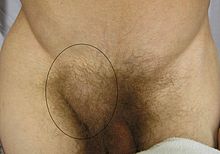

Symptoms and signs vary depending on the type of hernia. By far the most common hernias develop in theabdomenwhen a weakness in the abdominal wall evolves into a localized hole, or "defect", through whichadipose tissue,or abdominal organs covered withperitoneum,may protrude. Another common hernia involves thespinal discsand causessciatica.Ahiatus herniaoccurs when the stomach protrudes into themediastinumthrough the esophageal opening in thediaphragm.
Hernias might manifest with pain in the area, a noticeable lump, or less specific symptoms caused by pressure on an organ stuck within the hernia, potentially leading to organ dysfunction. Typically, fatty tissue is the initial entrant into a hernia, but it might also involve an organ. Hernias are caused by a disruption or opening in thefascia,or fibrous tissue, which forms the abdominal wall. It is possible for the bulge associated with a hernia to come and go, but the defect in the tissue will persist.
Symptoms may or may not be present in someinguinal hernias.In the case of reducible hernias, a bulge in thegroinor in another abdominal area can often be seen and felt. When standing, such a bulge becomes more obvious. Besides the bulge, other symptoms include pain in the groin that may also include a heavy or dragging sensation, and in men, there is sometimes pain and swelling in thescrotumaround thetesticulararea.[17]
Irreducible abdominal hernias or incarcerated hernias may be painful, but their most relevant symptom is that they cannot return to the abdominal cavity when pushed in. They may be chronic, although painless, and can lead to strangulation (loss of blood supply), obstruction (kinking of intestine), or both. Strangulated hernias are always painful and pain is followed by tenderness.Nausea,vomiting,orfevermay occur in these cases due tobowelobstruction. Also, the hernia bulge, in this case, may turn red, purple or dark and pink.[18]
In the diagnosis of abdominal hernias,imagingis the principal means of detecting internal diaphragmatic and other nonpalpable or unsuspected hernias.Multidetector CT(MDCT) can show with precision the anatomic site of the hernia sac, the contents of the sac, and any complications. MDCT also offers clear detail of the abdominal wall allowing wall hernias to be identified accurately.[19]
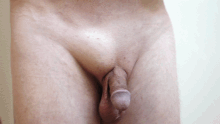
Complications[edit]
Untreated hernia may be complicated by:
- Inflammation
- Obstructionof any lumen, such asbowel obstructionin intestinal hernias
- Strangulation
- Hydroceleof the hernial sac
- Hemorrhage
- Autoimmuneproblems
- Irreducibilityor incarceration, in which it cannot be reduced, or pushed back into place,[20]at least not without very much external effort.[21]In intestinal hernias, this also substantially increases the risk of bowel obstruction and strangulation.
Causes[edit]
Causes of hiatus hernia vary depending on each individual. Among the multiple causes, however, are the mechanical causes which include: improper heavy weight lifting, hardcoughingbouts, sharp blows to the abdomen, and incorrectposture.[22]

Furthermore, conditions that increase the pressure of the abdominal cavity may also cause hernias or worsen the existing ones. Some examples would be: obesity, straining during a bowel movement or urination (constipation,enlarged prostate),chronic lung disease,and also, fluid in the abdominal cavity (ascites).[23]
Also, if muscles are weakened due topoor nutrition,smoking,andoverexertion,hernias are more likely to occur.
The physiological school of thought contends that in the case ofinguinal hernia,the above-mentioned are only ananatomicalsymptom of the underlyingphysiologicalcause. They contend that the risk of hernia is due to a physiological difference between patients who have hernia and those who do not, namely the presence ofaponeuroticextensions from thetransversus abdominisaponeurotic arch.[24]There isn't any proof that being physically active will cause a hernia to get stuck or make an existing hernia worse.[25]
Abdominal wall hernia may occur due to trauma. If this type of hernia is due to blunt trauma it is an emergency condition and could be associated with various solid organs and hollow viscus injuries.
Diagnosis[edit]
Inguinal[edit]
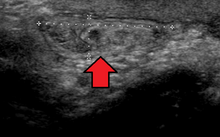


By far the most common hernias (up to 75% of all abdominal hernias) are inguinal hernias, which are further divided into the more commonindirect inguinal hernia(2/3, depicted here), in which the inguinal canal is entered via a congenital weakness at its entrance (the internal inguinal ring), and thedirect inguinal herniatype (1/3), where the hernia contents push through a weak spot in the back wall of the inguinal canal. Anindirect inguinal herniaand adirect inguinal herniacan be distinguished by their positioning in relation to the inferior epigastric vessels. An indirect hernia is situated laterally to these vessels, whereas a direct hernia is positioned medially to them. Inguinal hernias are the most common type of hernia in both men and women. In some selected cases, they may requiresurgery.
There are special cases where a direct and indirect hernia appear together. Apantaloon hernia(or saddlebag hernia) is a combined direct and indirect hernia when the hernial sac protrudes on either side of theinferior epigastric vessels.
Additionally, though very rare, two or more indirect hernias may appear together such as in adouble indirect hernia.[26]
Femoral[edit]
Femoral hernias occur just below theinguinal ligament,when abdominal contents pass into the weak area at the posterior wall of thefemoral canal.They can be hard to distinguish from the inguinal type (especially when ascending cephalad)[clarification needed]:however, they generally appear more rounded, and, in contrast to inguinal hernias, there is a strong female preponderance in femoral hernias. The incidence of strangulation in femoral hernias is high. Repair techniques are similar for femoral andinguinal hernia.
ACooper's herniais a femoral hernia with two sacs, the first being in the femoral canal, and the second passing through a defect in the superficial fascia and appearing almost immediately beneath the skin.
Umbilical[edit]
They involve protrusion of intra-abdominal contents through a weakness at the site of passage of theumbilical cordthrough theabdominal wall. Umbilical hernias in adults are largely acquired, and are more frequent inobeseorpregnantwomen. Abnormaldecussationof fibers at thelinea albamay be a contributing factor.
Incisional[edit]
An incisional hernia occurs when the defect is the result of an incompletely healed surgical wound. When these occur in medianlaparotomyincisions in thelinea alba,they are termedventral hernias.These occur in about 13% of people at 2 years following surgery.[27]
Diaphragmatic[edit]

Higher in the abdomen, an (internal) "diaphragmatic hernia" results when part of the stomach or intestine protrudes into thechest cavitythrough a defect in the diaphragm.
Ahiatus herniais a particular variant of this type, in which the normal passageway through which the esophagus meets the stomach (esophageal hiatus) serves as a functional "defect", allowing part of thestomachto (periodically) "herniate" into the chest. Hiatus hernias may be either "sliding",in which thegastroesophageal junctionitself slides through the defect into thechest,or non-sliding (also known aspara-esophageal), in which case the junction remains fixed while another portion of the stomach moves up through the defect. Non-sliding or para-esophageal hernias can be dangerous as they may allow the stomach to rotate and obstruct. Repair is usually advised.
Acongenital diaphragmatic herniais a distinct problem, occurring in up to 1 in 2000 births, and requiringpediatric surgery.Intestinal organs may herniate through several parts of thediaphragm,posterolateral (inBochdalek's triangle(lumbocostal triangle), resulting in aBochdalek hernia), or anteromedial-retrosternal (in the cleft offoramina of Morgagni(sternocostal triangle), resulting in aMorgagni's hernia).[28]
Other hernias[edit]
Since many organs or parts of organs can herniate through many orifices, it is very difficult to give an exhaustive list of hernias, with all synonyms andeponyms.The above article deals mostly with "visceral hernias", where the herniating tissue arises within the abdominal cavity. Other hernia types and unusual types of visceral hernias are listed below, in Alpha betical order:
- Abdominal wallhernias:
- Umbilical hernia
- Epigastric hernia:a hernia through thelinea albaabove theumbilicus.
- Spigelian hernia,also known as spontaneous lateral ventral hernia
- Amyand's hernia:containing the appendix vermiformis within the hernia sac
- Brain herniation,sometimes referred to as brain hernia, is a potentially deadly side effect of very highintracranial pressurethat occurs when a part of thebrainis squeezed across structures within theskull.
- Broad ligament hernia,of the uterus.[29][30]
- Double indirect hernia:an indirect inguinal hernia with two hernia sacs, without a concomitant direct hernia component (as seen in a pantaloon hernia).[26]
- Hiatus hernia:a hernia due to "short oesophagus" — insufficient elongation — stomach is displaced into the thorax
- Littre's hernia:a hernia involving aMeckel's diverticulum.It is named after the French anatomistAlexis Littré(1658–1726).
- Lumbarhernia: a hernia in the lumbar region (not to be confused with alumbar disc hernia), contains the following entities:
- Petit's hernia:a hernia through Petit's triangle (inferior lumbar triangle). It is named after French surgeonJean Louis Petit(1674–1750).
- Grynfeltt's hernia:a hernia through Grynfeltt-Lesshaft triangle (superior lumbar triangle). It is named after physician Joseph Grynfeltt (1840–1913).
- Maydl's hernia:two adjacent loops of small intestine are within a hernial sac with a tight neck. The intervening portion of bowel within the abdomen is deprived of its blood supply and eventually becomes necrotic.
- Obturator hernia:hernia throughobturator canal
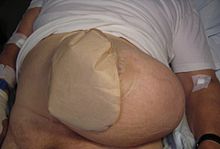
- Parastomal hernias, which is when tissue protrudes adjacent to astomatract.
- Paraumbilical hernia:a type of umbilical hernia occurring in adults
- Perineal hernia:a perineal hernia protrudes through the muscles and fascia of the perineal floor. It may be primary but usually is acquired following perineal prostatectomy, abdominoperineal resection of the rectum, or pelvic exenteration.
- Properitoneal hernia: rare hernia located directly above theperitoneum,for example, when part of inguinal hernia projects from thedeep inguinal ringto the preperitoneal space.
- Retrocolic hernia:entrapment of portions of the small intestine behind themesocolon.
- Richter's hernia:a hernia involving only one sidewall of the bowel, which can result in bowel strangulation leading to perforation through ischaemia without causingbowel obstructionor any of its warning signs. It is named after German surgeonAugust Gottlieb Richter(1742–1812).
- Sliding hernia:occurs when an organ drags along part of the peritoneum, or, in other words, the organ is part of the hernia sac. Thecolonand theurinary bladderare often involved. The term also frequently refers tosliding hernias of the stomach.
- Sciatic hernia: this hernia in thegreater sciatic foramenmost commonly presents as an uncomfortable mass in the gluteal area. Bowel obstruction may also occur. This type of hernia is only a rare cause ofsciaticneuralgia.
- Sports hernia:a hernia characterized by chronic groin pain in athletes and a dilatedsuperficial inguinal ring.
- Tibialis anterior hernia:can present as a bulge in the shins. Pain on rest, walking, or during exercise may occur. The bulge can typically not be present unless pressure or fle xing of the leg occurs.[31][32][33]
- Velpeau hernia:a hernia in the groin in front of the femoral blood vessels
Treatment[edit]

Truss[edit]
The benefits of the use of an external device to maintain reduction of the hernia without repairing the underlying defect (such as herniatrusses,trunks, belts, etc.) are unclear.[1]
Surgery[edit]
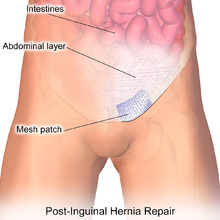
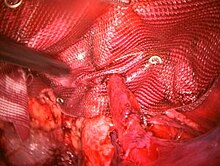
Surgery is recommended for some types of hernias to prevent complications such as obstruction of the bowel or strangulation of the tissue, although umbilical hernias and hiatus hernias may be watched, or are treated with medication.[34]Most abdominal hernias can be surgically repaired, but surgery has complications. Prior to surgery patients should be medically optimized receive guidance about changing factors that can be controlled, such as quitting smoking, managing medical conditions like diabetes effectively, and working on losing weight.
Three primary methods can be utilized: open surgery,laparoscopy,or robotic techniques. Fi xing an inguinal hernia usinglaparoscopycauses less pain, speeds up recovery, and shows similar low rates of the hernia coming back compared to the traditional open repair method. However, open surgery can be done sometimes without general anesthesia. Using local anesthesia for open groin hernia repair, particularly in patients with additional health issues, leads to fewer complications and reduced costs.[35]Studies show that compared to regional or general anesthesia, local anesthesia results in less postoperative pain, shorter recovery times, and decreased unplanned overnight stays.[36]However, it might not be enough for repairing large hernias or in patients with abdominal domain loss, where general anesthesia is preferred.
| Advantages | Disadvantages |
|---|---|
|
Robot-assistedhernia surgery has also recently gained popularity as safe alternatives to open surgery. Robotic surgery for inguinal hernia repair shows outcomes comparable to laparoscopic surgery. The rates of overall complications, long-lasting postoperative pain, urinary retention, and 30-day re-admission are very similar between these two methods.[39]Just like in other areas of general surgery, it has been noted that robotic surgery for inguinal hernia repair takes more time in the operating room compared to the laparoscopic approach.[39]
Uncomplicated hernias are principally repaired by pushing back, or "reducing", the herniated tissue, and then mending the weakness in muscle tissue (an operation calledherniorrhaphy). If complications have occurred, the surgeon will check the viability of the herniated organ and remove part of it if necessary.
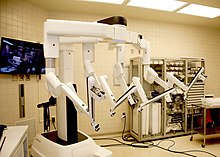
Muscle reinforcement techniques often involve synthetic materials (amesh prosthesis).[40]The mesh is placed either over the defect (anterior repair) or under the defect (posterior repair). At timesstaplesare used to keep the mesh in place. Thesemesh repair methodsare often called "tension free" repairs because, unlike somesuturemethods (e.g., Shouldice), muscle is not pulled together under tension. However, this widely used terminology is misleading, as there are manytension-free suture methodsthat do not use mesh (e.g., Desarda, Guarnieri, Lipton-Estrin, etc.).
Evidence suggests that tension-free methods (with or without mesh) often have lower percentage of recurrences and the fastest recovery period compared totension suture methods.However, the use of prosthetic mesh appears to have a higher likelihood of causing long-term pain and can also lead to infections.[41]
The frequency of surgical correction ranges from 10 per 100,000 (U.K.) to 28 per 100,000 (U.S.).[1]After elective surgery, the 30-day mortality rate for inguinal or femoral hernia repair stands at 0.1 percent, but it increases to 2.8 to 3.1 percent after urgent surgery.[42]When a bowel resection is part of the hernia repair, the mortality rate is even higher.[43]Older age, femoral hernias, female sex, and urgent repair are identified as other factors linked to a higher risk of mortality.[44]
Post-Operative Complications
Some complications from surgery in order of prevalence include aseroma/hematomaformation, urinary retention,neuralgias,testicular pain/swelling, mesh infection/wound infection, and recurrence.[45]A seroma is often seen after an indirect hernia repair and resolves spontaneously over 4–6 weeks. To prevent a seroma it's important to reduce the amount of cutting around the hernia sac where it's connected to the cord structures.[45]Additionally, securely attaching the hernia sac to the pubic bone and creating small openings in the tissue around a direct hernia can help.[45]In cases of heavy bleeding or extensive cutting, certain surgeons may opt to insert a drain.[45]Urinary retention is often seen in elderly patients, these patients can be catheterized prior to surgery if there is a risk.[45]Other complications may arisepost-operatively,including rejection of themeshthat is used to repair the hernia. In the event of a mesh rejection, the mesh will very likely need to be removed. Mesh rejection can be detected by obvious, sometimes localized swelling and pain around the mesh area. Continuous discharge from the scar is likely for a while after the mesh has been removed. A surgically treated hernia can lead to complications such asinguinodynia.
Recovery[edit]
Many patients are managed throughday surgerycenters and are able to return to work within a week or two, though intense activities are prohibited for a longer period. People who have their hernias repaired with mesh often recover within a month, but pain can last longer. Surgical complications may include pain that lasts more than three months, surgical site infections, nerve and blood vessel injuries, injury to nearby organs, and hernia recurrence. Pain that lasts more than three months occurs in about 10% of people following hernia repair.[1]
References[edit]
- ^abcdefghijklmnopqrstuvwxyzaaabacadaeFitzgibbons RJ, Forse RA (February 2015). "Clinical practice. Groin hernias in adults".The New England Journal of Medicine.372(8): 756–63.doi:10.1056/NEJMcp1404068.PMID25693015.
- ^abcdDomino FJ (2014).The 5-minute clinical consult 2014(22nd ed.). Philadelphia, Pa.: Wolters Kluwer Health/Lippincott Williams & Wilkins. p. 562.ISBN9781451188509.Archivedfrom the original on 2017-08-22.
- ^abcdefghRoman S, Kahrilas PJ (October 2014). "The diagnosis and management of hiatus hernia".BMJ.349:g6154.doi:10.1136/bmj.g6154.PMID25341679.S2CID7141090.
- ^abVos T, Allen C, Arora M, Barber RM, Bhutta ZA, Brown A, et al. (GBD 2015 Disease and Injury Incidence and Prevalence Collaborators) (October 2016)."Global, regional, and national incidence, prevalence, and years lived with disability for 310 diseases and injuries, 1990-2015: a systematic analysis for the Global Burden of Disease Study 2015".Lancet.388(10053): 1545–1602.doi:10.1016/S0140-6736(16)31678-6.PMC5055577.PMID27733282.
- ^abWang H, Naghavi M, Allen C, Barber RM, Bhutta ZA, Carter A, et al. (GBD 2015 Mortality and Causes of Death Collaborators) (October 2016)."Global, regional, and national life expectancy, all-cause mortality, and cause-specific mortality for 249 causes of death, 1980-2015: a systematic analysis for the Global Burden of Disease Study 2015".Lancet.388(10053): 1459–1544.doi:10.1016/s0140-6736(16)31012-1.PMC5388903.PMID27733281.
- ^abc"Hernia".MedlinePlus.U.S. National Library of Medicine. 9 August 2014.Archivedfrom the original on 16 March 2015.Retrieved12 March2015.
- ^Öberg S, Andresen K, Rosenberg J (2017)."Etiology of Inguinal Hernias: A Comprehensive Review".Frontiers in Surgery.4:52.doi:10.3389/fsurg.2017.00052.PMC5614933.PMID29018803.
- ^Mihailov E, Nikopensius T, Reigo A, Nikkolo C, Kals M, Aruaas K, et al. (February 2017)."Whole-exome sequencing identifies a potential TTN mutation in a multiplex family with inguinal hernia".Hernia.21(1): 95–100.doi:10.1007/s10029-016-1491-9.PMC5281683.PMID27115767.
- ^Sezer S, Şimşek N, Celik HT, Erden G, Ozturk G, Düzgün AP, et al. (August 2014). "Association of collagen type I Alpha 1 gene polymorphism with inguinal hernia".Hernia.18(4): 507–12.doi:10.1007/s10029-013-1147-y.PMID23925543.S2CID22999363.
- ^Gong Y, Shao C, Sun Q, Chen B, Jiang Y, Guo C, et al. (March 1994)."Genetic study of indirect inguinal hernia".Journal of Medical Genetics.31(3): 187–92.doi:10.1136/jmg.31.3.187.PMC1049739.PMID8014965.
- ^Ma, Q.; Jing, W.; Liu, X.; Liu, J.; Liu, M.; Chen, J. (24 March 2023)."Trends of inguinal, femoral, and abdominal hernia from 1990 to 2019".International Journal of Surgery (London, England).109(3): 333–342.doi:10.1097/JS9.0000000000000217.PMC10389329.PMID37093073.
- ^Nigam VK (2009).Essentials of Abdominal Wall Hernias.I. K. International Pvt Ltd. p. 6.ISBN9788189866938.Archivedfrom the original on 2017-09-08.
- ^Park, Adrian E.; Roth, J. Scott; Kavic, Stephen M. (2006-05-01)."Abdominal Wall Hernia".Current Problems in Surgery.43(5): 326–375.doi:10.1067/j.cpsurg.2006.02.004.ISSN0011-3840.PMID16679124.
- ^Vos T, Barber RM, Bell B, Bertozzi-Villa A, Biryukov S, Bolliger I, et al. (Global Burden of Disease Study 2013 Collaborators) (August 2015)."Global, regional, and national incidence, prevalence, and years lived with disability for 301 acute and chronic diseases and injuries in 188 countries, 1990-2013: a systematic analysis for the Global Burden of Disease Study 2013".Lancet.386(9995): 743–800.doi:10.1016/s0140-6736(15)60692-4.PMC4561509.PMID26063472.
- ^Naghavi M, Wang H, Lozano R, Davis A, Liang X, Zhou M, et al. (GBD 2013 Mortality and Causes of Death Collaborators) (January 2015)."Global, regional, and national age-sex specific all-cause and cause-specific mortality for 240 causes of death, 1990-2013: a systematic analysis for the Global Burden of Disease Study 2013".Lancet.385(9963): 117–71.doi:10.1016/S0140-6736(14)61682-2.PMC4340604.PMID25530442.
- ^Park AE, Roth JS, Kavic SM. Abdominal wall hernia. Curr Probl Surg. 2006 May;43(5):326-75. doi: 10.1067/j.cpsurg.2006.02.004. PMID 16679124.
- ^"Inguinal hernia".The Mayo Clinic.Archivedfrom the original on 2010-02-13.Retrieved2010-05-24.
- ^"What is Hernia? - Causes, Symptoms, Diagnosis".pristyncare.Retrieved2023-12-16.
- ^Lee HK, Park SJ, Yi BH (2010)."Multidetector CT reveals diverse variety of abdominal hernias".Diagnostic Imaging.32(5): 27–31. Archived fromthe originalon 2010-06-18.Retrieved2010-06-25.
- ^Goers TA, Klingensmith ME, Chen LE, Glasgow SC (2008).The Washington manual of surgery.Philadelphia: Wolters Kluwer Health/Lippincott Williams & Wilkins.ISBN978-0-7817-7447-5.
- ^"Incarcerated".onlinedictionary.datasegment.Archived fromthe originalon 2008-11-20.Citing: Webster 1913
- ^"Hiatal Hernia Symptoms, Causes And Relation To Acid Reflux And Heartburn".Archived fromthe originalon October 28, 2008.Retrieved2010-05-24.
- ^Balentine JR. Stöppler MC (ed.)."Hernia Causes".eMedicineHealth.WebMD.Archivedfrom the original on 2010-05-31.Retrieved2010-05-24.
- ^Desarda MP (April 2003)."Surgical physiology of inguinal hernia repair--a study of 200 cases".BMC Surgery.3:2.doi:10.1186/1471-2482-3-2.PMC155644.PMID12697071.
- ^Montgomery, John; Dimick, Justin B.; Telem, Dana A. (2018-09-11)."Management of Groin Hernias in Adults-2018".JAMA.320(10): 1029–1030.doi:10.1001/jama.2018.10680.ISSN1538-3598.PMID30128503.S2CID205095374.
- ^abJones R (2013)."An unexpected finding during an inguinal herniorrhaphy: report of an indirect hernia with two hernia sacs".Journal of Pediatric Surgery Case Reports.1(10): 331–332.doi:10.1016/j.epsc.2013.09.002.
- ^Bosanquet DC, Ansell J, Abdelrahman T, Cornish J, Harries R, Stimpson A, et al. (2015)."Systematic Review and Meta-Regression of Factors Affecting Midline Incisional Hernia Rates: Analysis of 14,618 Patients".PLOS ONE.10(9): e0138745.Bibcode:2015PLoSO..1038745B.doi:10.1371/journal.pone.0138745.PMC4577082.PMID26389785.
- ^Arráez-Aybar LA, González-Gómez CC, Torres-García AJ (May 2009)."Morgagni-Larrey parasternal diaphragmatic hernia in the adult".Revista Espanola de Enfermedades Digestivas /.101(5): 357–66.PMID19527083.
- ^Ozben V, Aliyeva Z, Barbur E, Guler I, Karahasanoglu T, Baca B (September 2020). "Laparoscopic management of incarcerated broad ligament hernia in a patient with bilateral parametrium defects - a video vignette".Colorectal Disease.22(9): 1197–1198.doi:10.1111/codi.15039.PMID32180330.S2CID212739555.
- ^Hiraiwa K, Morozumi K, Miyazaki H, Sotome K, Furukawa A, Nakamaru M (March 2006)."Strangulated hernia through a defect of the broad ligament and mobile cecum: a case report".World Journal of Gastroenterology.12(9): 1479–80.doi:10.3748/wjg.v12.i9.1479.PMC4124335.PMID16552826.
- ^Nguyen JT, Nguyen JL, Wheatley MJ, Nguyen TA (2013)."Muscle hernias of the leg: A case report and comprehensive review of the literature".The Canadian Journal of Plastic Surgery.21(4): 243–7.doi:10.1177/229255031302100408.PMC3910527.PMID24497767.
- ^Masoumi A, Ramogida G (April 2020)."Tibialis anterior herniation - a rare clinical entity: a case report and review of the literature".The Journal of the Canadian Chiropractic Association.64(1): 88–91.PMC7250514.PMID32476672.
- ^Sharma N, Kumar N, Verma R, Jhobta A (2017-05-31)."Tibialis Anterior Muscle Hernia: A Case of Chronic, Dull Pain and Swelling in Leg Diagnosed by Dynamic Ultrasonography".Polish Journal of Radiology.82:293–295.doi:10.12659/PJR.900846.PMC5462483.PMID28638493.
- ^"Hernia".U.K. National Health Service.Archivedfrom the original on 2017-07-14.Retrieved2017-07-23.
- ^Balentine, Courtney J.; Meier, Jennie; Berger, Miles; Reisch, Joan; Cullum, Munro; Lee, Simon C.; Skinner, Celette Sugg; Brown, Cynthia J. (February 2021)."Using Local Anesthesia for Inguinal Hernia Repair Reduces Complications in Older Patients".The Journal of Surgical Research.258:64–72.doi:10.1016/j.jss.2020.08.054.ISSN1095-8673.PMC7968932.PMID33002663.
- ^van Veen, Ruben N.; Mahabier, Chander; Dawson, Imro; Hop, Wim C.; Kok, Niels F. M.; Lange, Johan F.; Jeekel, Johannus (March 2008)."Spinal or local anesthesia in lichtenstein hernia repair: a randomized controlled trial".Annals of Surgery.247(3): 428–433.doi:10.1097/SLA.0b013e318165b0ff.ISSN0003-4932.PMID18376185.S2CID22487510.
- ^abcKlingensmith, Mary E. (2008).The Washington Manual of Surgery.Philadelphia: Lippincott Williams & Wilkins.ISBN978-0-7817-7447-5.
- ^ab"Overview | Laparoscopic surgery for inguinal hernia repair | Guidance | NICE".nice.org.uk.2004-09-22.Retrieved2023-11-09.
- ^abSolaini, Leonardo; Cavaliere, Davide; Avanzolini, Andrea; Rocco, Giuseppe; Ercolani, Giorgio (2022)."Robotic versus laparoscopic inguinal hernia repair: an updated systematic review and meta-analysis".Journal of Robotic Surgery.16(4): 775–781.doi:10.1007/s11701-021-01312-6.ISSN1863-2483.PMC9314304.PMID34609697.
- ^Kamtoh G, Pach R, Kibil W, Matyja A, Solecki R, Banas B, Kulig J (September 2014)."Effectiveness of mesh hernioplasty in incarcerated inguinal hernias".Wideochirurgia I Inne Techniki Maloinwazyjne = Videosurgery and Other Miniinvasive Techniques.9(3): 415–9.doi:10.5114/wiitm.2014.43080.PMC4198637.PMID25337167.
- ^Sohail MR, Smilack JD (June 2004)."Hernia repair mesh-associated Mycobacterium goodii infection".Journal of Clinical Microbiology.42(6): 2858–60.doi:10.1128/JCM.42.6.2858-2860.2004.PMC427896.PMID15184492.
- ^Arenal, Juan J.; Rodríguez-Vielba, Paloma; Gallo, Emiliano; Tinoco, Claudia (2002)."Hernias of the abdominal wall in patients over the age of 70 years".The European Journal of Surgery = Acta Chirurgica.168(8–9): 460–463.doi:10.1080/110241502321116451.ISSN1102-4151.PMID12549685.
- ^Abi-Haidar, Youmna; Sanchez, Vivian; Itani, Kamal M. F. (September 2011)."Risk factors and outcomes of acute versus elective groin hernia surgery".Journal of the American College of Surgeons.213(3): 363–369.doi:10.1016/j.jamcollsurg.2011.05.008.ISSN1879-1190.PMID21680204.
- ^Nilsson, Hanna; Stylianidis, Georgios; Haapamäki, Markku; Nilsson, Erik; Nordin, Pär (April 2007)."Mortality after groin hernia surgery".Annals of Surgery.245(4): 656–660.doi:10.1097/01.sla.0000251364.32698.4b.ISSN0003-4932.PMC1877035.PMID17414617.
- ^abcdeChowbey, Pradeep K; Pithawala, Murtaza; Khullar, Rajesh; Sharma, Anil; Soni, Vandana; Baijal, Manish (September 2006)."Complications in groin hernia surgery and the way out".Journal of Minimal Access Surgery.2(3): 174–177.doi:10.4103/0972-9941.27734.ISSN0972-9941.PMC2999781.PMID21187992.
